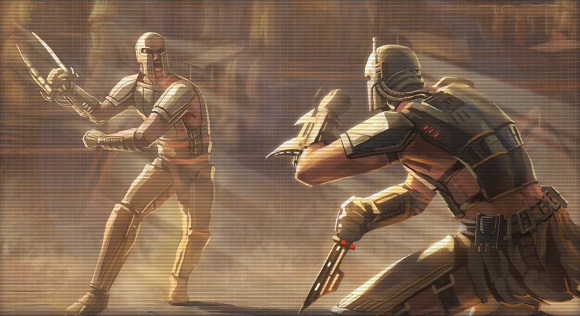Gladiator Game
The Gladiator Game appears to be known under other names and have several variants, see, for example A Colonel Blotto Gladiator Game for history and variations. My source is Haim Shapira's popular book on Game Theory. This is not so much a game as a problem of finding an optimal strategy for a team to win in a series of one-on-one meets.
So there are two teams of gladiators, each of whom has been assigned a strength attribute (a positive number). When two gladiators from different teams meet, their chances to win the duel are proportional to their strengths. A fellow that loses a duel, dies and takes no part in further combats. The winner - who returns to the bench and is immediately ready for another fight - has his strength augmented by that of the loser. The last team standing wins.
Let's there be two teams with individual strengths (in, say, non-decreasing order) $\{a_{1}, a_{2},\ldots,a_{m}\}$ and $\{b_{1}, b_{2},\ldots,b_{n}\}.$ Find an optimal strategy for a team, i.e., the order of sending team members to duel opponents from the other team, to maximize its chances of winning the competition.
References
- Haim Shapira, Gladiators, Pirates and Games of Trust: How Game Theory, Strategy and Probability Rule Our Lives, Watkins Publishing, 2017
|Contact| |Front page| |Contents| |Inventor's Paradox| |Up|
Copyright © 1996-2018 Alexander Bogomolny
There is no optimal strategy. No strategy effects the chances of a team to win the competition. Let $\displaystyle A=\sum_{i=1}^{m}a_{i}$ and $\displaystyle B=\sum_{i=1}^{n}b_{i}.$ Then the chances of a team to win are proportional to its total strength, i.e., for the first team, it is $\displaystyle\frac{A}{A+B};$ for the second, it is $\displaystyle\frac{B}{A+B}.$
The proof is by induction on $n+m,$ assuming both $n$ and $m$ are greater than zero.
The claim is certainly true for $m=n=1.$ Assume it is true for $m+n=N,$ and let now that one team still has $m$ members, the other membership of the other grew to $n+1.$ So now $\displaystyle A=\sum_{i=1}^{m}a_{i}$ and $\displaystyle B=\sum_{i=1}^{n+1}b_{i}.$
For the first duel, the first team sends a gladiator of strength $a,$ the second a gladiator of strength $b.$ The first wins with the probability of $\displaystyle\frac{a}{a+b},$ the second with the probability of $\displaystyle\frac{b}{a+b}.$
Depending on who wins that duel, there will be two possible distributions of strength:
$a$ wins: $\{a_{1},\ldots,a+b,\ldots,a_{m}\}$ and $\{b_{1},\ldots,\overline{b}\ldots,b_{n+1}\},$
$b$ wins: $\{a_{1},\ldots,\overline{a},\ldots,a_{m}\}$ and $\{b_{1},\ldots,b+a\ldots,b_{n+1}\},$
where overline means the absence of the fighter.
According to the induction assumption, in the first case, the chances of the first team to win equal $\displaystyle\frac{A+b}{A+B},$ in the second case they are equal to $\displaystyle\frac{A-a}{A+B},$ making the overall probability to be
$\begin{align}\displaystyle P_{a}&=\frac{a}{a+b}\cdot\frac{A+b}{A+B}+\frac{b}{a+b}\cdot\frac{A-a}{A+B}\\ &=\frac{aA+bA}{(a+b)(A+B)}\\ &=\frac{A}{A+B}, \end{align}$
as claimed.
- What Is Probability?
- Intuitive Probability
- Probability Problems
- Sample Spaces and Random Variables
- Probabilities
- Conditional Probability
- Dependent and Independent Events
- Algebra of Random Variables
- Expectation
- Probability Generating Functions
- Probability of Two Integers Being Coprime
- Random Walks
- Probabilistic Method
- Probability Paradoxes
- Symmetry Principle in Probability
- Non-transitive Dice
|Contact| |Front page| |Contents| |Probability| |Induction|
Copyright © 1996-2018 Alexander Bogomolny
73581502

